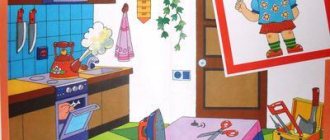Consultation “Life safety rules for preschoolers”
Larisa Yakieva
Consultation “Life safety rules for preschoolers”
Explanatory note
Often, being drawn into the cycle of everyday life, we forget about how many unexpected dangers await a person on the path of life . Our carelessness and indifference to our health often lead to tragedy. But a person will be able to prevent trouble, protect himself and his loved ones from danger if he has basic knowledge of the basics of life safety .
This knowledge is formed in the process of education, therefore, teaching children to ensure the safety of their life the life and health of citizens should take part .
The foundations of knowledge on life safety are laid already in preschool age . One of the main tasks in working with preschoolers is teaching the rules of safe behavior .
Based on its physiological characteristics, a baby cannot independently determine the full extent of the danger of its existence. Therefore, nature entrusts an adult with the mission of protecting his child. Children need to be wisely helped to avoid harm, because it is impossible to lead them by the hand and hold them near you all the time. It is necessary to cultivate the habit correctly , teach how to communicate with animals, and explain how to behave in the yard, on the street and at home. It is necessary to instill in children the skills to behave in situations fraught with injury, to form in them an idea of the most typical, frequently occurring situations. Rules of behavior and various prohibitions are directly related to human living . They have a certain, sometimes vital meaning . However, adults, trying to protect children from physical and mental trauma, as a rule , either use long instructions and moralizing, or regulate children’s behavior through direct prohibitions. Both ways are ineffective. In the first case, the adult has the illusion that the child has understood the meaning of this or that rule of behavior , whereas in fact this is not always true, and in changed circumstances the child may again make a dangerous mistake. The second path inevitably leads to the need for constant attention and control from an adult, which is not always possible. In addition, if prohibitions are imposed on numerous actions of the child, he will not be able to carry out them fully, and some of the rules will inevitably be broken. This can lead to accidents and injuries.
We all wish our children happiness, try to protect them from troubles and adversity, and often ask ourselves questions: How to combine injury prevention with helplessness prevention? safety for a child at home , while simultaneously developing his initiative and independence? What dangerous situations should be categorically excluded, for which and when should the child be prepared?
The main rule is that you need to talk to children about safety seriously, using all available means.
How to raise a child to be confident and careful? What techniques and methods will be most effective in your work? How to teach a child the basics of personal safety , without intimidation, instill in him stable skills of safe behavior in order to minimize the very possibility of potentially dangerous situations arising.
Adults must find such approaches to educating the child’s personality and organize their pedagogical activities in such a way that education becomes effective, efficient, and effective.
Children, especially young children, find it difficult to imagine themselves in someone else's place. They need to feel the situation, to immerse themselves in it. Therefore, the most effective teaching occurs when the child’s feelings are hurt. When he is interested, curious and a little scared: what if this happened to me?
For this I made a soft book “ Safety Rules ”
safety book for adults and children ."
The book is intended for joint activities between adults and children. The goal is to develop in students a responsible attitude towards personal and public safety and to develop their experience of safe life activities .
Tasks :
Educational:
To form knowledge in older children about the culture of behavior on the road;
Deepen and expand children's knowledge about the rules of the road and behavior on the roads, road users (passenger, pedestrian, driver)
.
Improve children's knowledge of fire prevention and during fires. *To develop children’s skills and abilities in communicating with strangers and those left alone at home.
Deepen and expand children's knowledge about behavior in the sun, water, during a thunderstorm, in the forest, with medicines and dangerous objects
Educational:
Develop the ability correctly in a difficult situation.
Develop grammatically correct speech in children .
Educational:
Cultivate a caring attitude towards your health.
With a soft book " safety rules "
children play with interest, they themselves become heroes of certain dangerous situations.
rules of behavior on the road in a fun and playful way , learn how to cross the road correctly , learn the meanings of traffic light colors, and get acquainted with a zebra crossing.
and road signs, they will learn to understand the traffic controller’s gestures and signals. Children will be able to fully understand not only how to behave on the road, but will also be able to play and learn while playing. Thus, the learning process will not be a burdensome task, but will turn into a favorite pastime. Removable elements are attached to the book using Velcro, buttons, and a zipper. This allows children to develop fine motor skills while working with a book and teach children how to unfasten and fasten them.
The pages of the book reflect elements of the street and road. Removable elements (houses, trucks, cars, pedestrians)
help create a variety of scenes and situations that may arise with pedestrians and passengers on the street.
You can also play the didactic game “If there is a fire”
, from which children learn how to behave in case of fire, how to call the fire department.
I offer several didactic games that can be used in playing with a book:
"A person's appearance can be deceiving"
Goal: to explain to children that the pleasant appearance of a stranger does not always mean his good intentions.
1. Thematic conversation.
2. Simulation of situations: a stranger offers candy; a stranger invites you to ride in a car with him; the stranger calls to him. 3. Did. game "Good and Evil"
.
Goal: to help the child remember his close relatives and friends of his parents, to whom he could turn for help.
"Meeting a Stranger"
Goal: to introduce the basic
rules of behavior with strangers.
.Did. game "Fairy-tale heroes good and evil"
.
.Training game “An unfamiliar uncle came up to me and asked...” (simulation of the situation)
5. View thematic illustrations, talk about them.
"If a stranger comes into the house"
Goal: teach children
to behave correctly at home when they are alone.
Simulation of situations: “a stranger knocks on the door; the doctor came; the postman came"
.Training game
(persuasion, promises, gentle voice)
.
.Conversation with children. .Did. game “You can - you can’t”
Place the phone number of your mother, father, neighbors, grandmother (grandfather)
"Fire"
Goal: repeat phone number 01, teach how to dial the number correctly .
.Teacher's story and conversation about fires. Training game “If there is a fire in the apartment”
2. "Service 02"
Goal: to introduce children to service 02.
.Simulation of the situation “I’m playing at home alone, they’re knocking loudly on the door and trying to break it”
Training game
“Dial number 02 and tell me what happened”
Purpose: to teach at home with children how to dial emergency numbers correctly
3. "Ambulance"
Goal: introduce children to the phone number «03»
., learn to call an ambulance.
.Game training “Learning to dial numbers 01,02,03.”
.Conversation on the topic.
(from the personal experience of children)
. Outdoor game “Give way to an ambulance
(fire, police)
” (children become cars, at the signal of the leader, someone turns into a special service car, everyone else must stop and give way. The one who violates is eliminated .)
On the water, in the sun..."
Purpose: explain the need to comply with safety rules while on vacation .
.Outdoor game “Collect things by measure”
.
(illustrations can be used)
.Did.
game “Acquaintance with the sea, lake, river” (for the development of imagination)
Game
“We are swimming”
Conversation about
the rules of behavior on vacation .
Remember kids, pills are for candy."
Purpose: to teach safe handling of medications.
Simulation of the situation: - the children were left alone at home, playing and found a box of medicine. Training game “How to call an ambulance?”
.Did.
yoke “What is the medicine here?”
Conversation about
the rules for storing medicines in the house.




